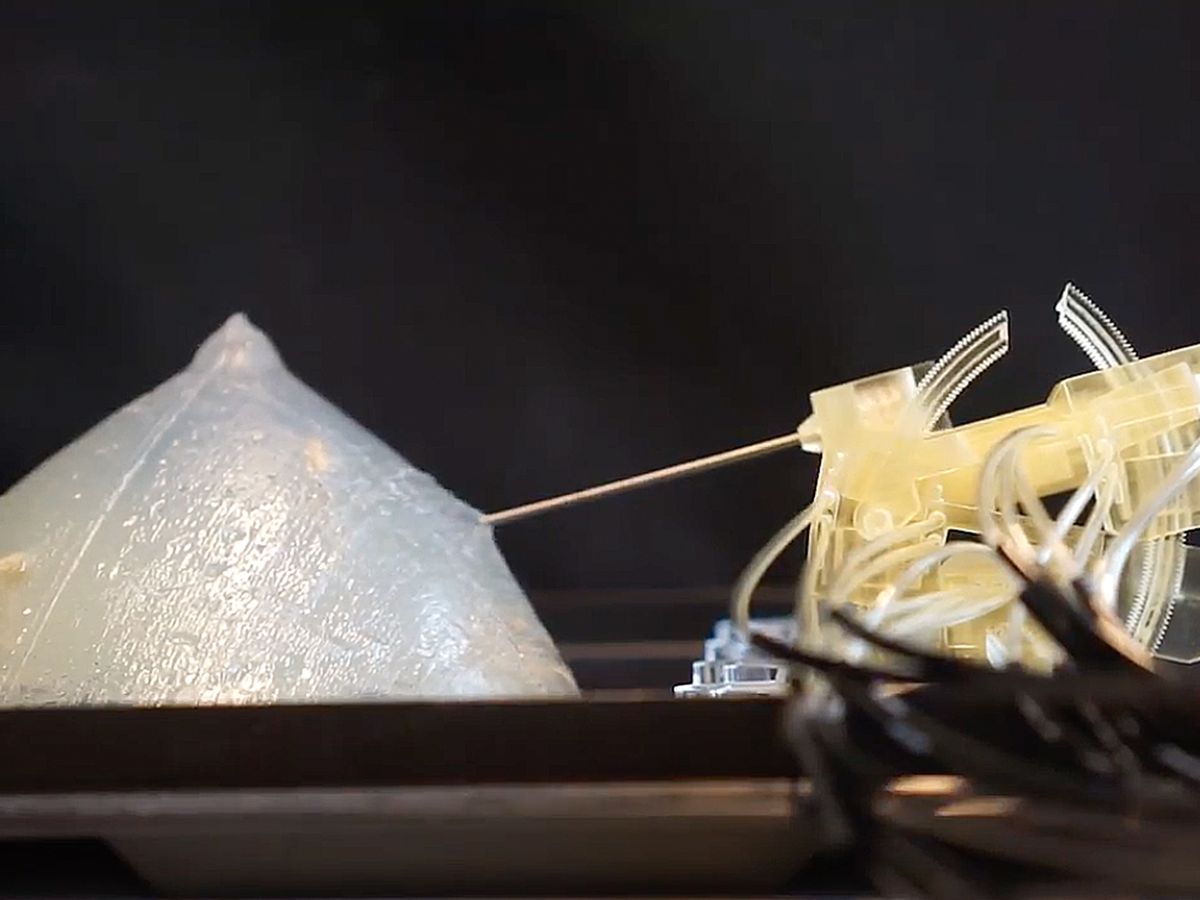We’re still sifting through the more than 1,200 presentations at IROS 2017, IEEE’s massive intelligent robots conference held last month in Vancouver. This week we found some terrifying gems: surgical robots that snake up the nose, puncture the breast, and suction intestinal tissue with motions so jarring they will make any patient glad (or longing) to be passed out during the procedure.
We previously highlighted 20 of our favorite videos from the conference. Now, with Halloween approaching, we give you: the five most gruesome (maniacal laugh).
1. Stormram: The breast gouger of doom
Sadistically named the “Stormram,” this robot punctures the breast in one slow, ominous motion, to extract a tissue sample. And yes, women may someday elect to use it.
Suspicious lumps in the breast must be sampled, or biopsied, in order to determine whether or not they are cancerous. This is often conducted manually with a needle, with magnetic resonance imaging (MRI) to guide its placement. But that requires sliding the patient in and out of an MRI scanner multiple times to allow a radiologist to adjust the position of the needle.
The Stormram robot goes into the MRI scanner with the patient, and takes the biopsy in real time. A Dutch team led by Stefano Stramigioli at the Universiteit Twente in Enschede built the bot, using materials safe to use with MRI and curved stepper motors to drive the needle’s motion.
The needle is surprisingly big and the motors make a sound that’s rather harrowing. But if it means getting out of an MRI machine faster, perhaps women will go for it (assuming this video doesn’t scare everyone away first).
2. Nasal cavity torture tool
This gadget is built to go where no tool (or finger) has gone before: waaaaaay up into the nose to a narrow, complex structure adjacent to the brain called the olfactory cleft. That’s where olfactory cells—those that give us our sense of smell—reside. And so far, no device is small enough, flexible enough, and controllable enough to get in there to inspect it.
And for the most part, people are just fine with that.
But French engineers led by Pierre Renaud at the Institut National des Sciences Appliquées in Strasbourg, not content with this technical limitation, want in. They say inspection of the olfactory cleft could lead to better disease diagnoses. After all, loss of smell has been correlated with neurodegenerative disorders.
So they built a device and tested it on a 3D model of the nasal cavity. The flexible tool snakes up the nose and telescopes out in concentric tubes with the tip leading the way. Once it reaches its destination, the innermost tube deploys from the tip and, um, rotates. A fiber-based optical coherence tomography probe generates a 3D scan of the tissue.
Best case scenario: The olfactory cells look fine and the device gently retracts back out of the nose. Nothing like how it went for Quaid in Total Recall. Hopefully.
3. Double-armed urethra snake
This double-arm surgical tool could enable doctors to remove superficial tumors on the bladder more thoroughly than current methods. The catch: The bot snakes into the body through the urethra.
In men, the urethra is six to 11 inches long and, lets face it: not very wide. The proposed device, developed by Tim Lueth and his team at Technische Universität München in Garching, Germany, is seven millimeters in diameter.
So not small. But also not bigger than current bladder tumor removal tools which, unfortunately, also enter through the urethra. Lueth and his team are attempting to improve upon that method, called transurethral resection of bladder tumors, or TURBT. The current tools for this surgery are limited in their maneuverability, sometimes preventing surgeons from getting to all the cancerous tissue.
In contrast, Leuth’s flexible tool boasts 10 degrees of freedom, enabling the surgeon to reach all areas of the bladder, including behind it. The team is working on improving the device to balance its flexibility with its ability to transmit enough force. Attempts at further miniaturization were, unfortunately, not named as a priority for future development.
4. Pop and chop tissue suction
It suctions tissue like skin caught in a vacuum hose, popping it up just enough to give surgeons a better angle to cut. Its developers, led by Robert Wood at Harvard University in Cambridge, Massachusetts, say the tool could expand surgeons’ capabilities during minimally invasive surgery on the gastrointestinal tract.
During such procedures, a surgeon is tasked with steering the tip of an endoscope to the appropriate spot, applying tension to the tissue, and manipulating electro-cautery tools to make the cut—all in a very small space. Wood’s tool would automate the act of placing tissue under tension, leaving the surgeon free to focus on making the cuts. The group calls it “pop-up tissue retraction.” Pop and chop!
5. Autonomous flesh-cutter
A flesh-cutting robot went head-to-head with a human surgeon to see who could cut pig skin, fat, and muscle more accurately. In a video featuring cake pans of smoldering swine tissue, the robot, called STAR, shows us how to really slice meat. IEEE Spectrum’s Eliza Strickland has the details.
Emily Waltz is a features editor at Spectrum covering power and energy. Prior to joining the staff in January 2024, Emily spent 18 years as a freelance journalist covering biotechnology, primarily for the Nature research journals and Spectrum. Her work has also appeared in Scientific American, Discover, Outside, and the New York Times. Emily has a master's degree from Columbia University Graduate School of Journalism and an undergraduate degree from Vanderbilt University. With every word she writes, Emily strives to say something true and useful. She posts on Twitter/X @EmWaltz and her portfolio can be found on her website.



